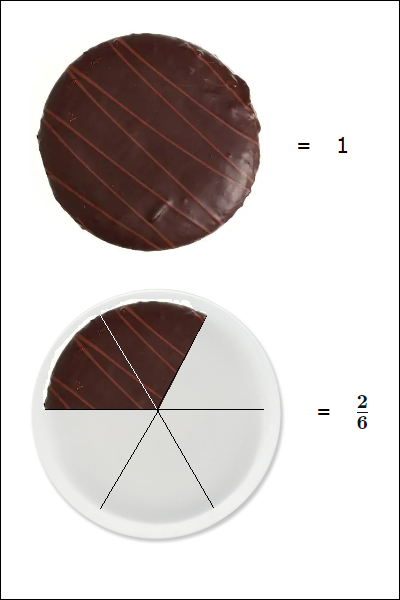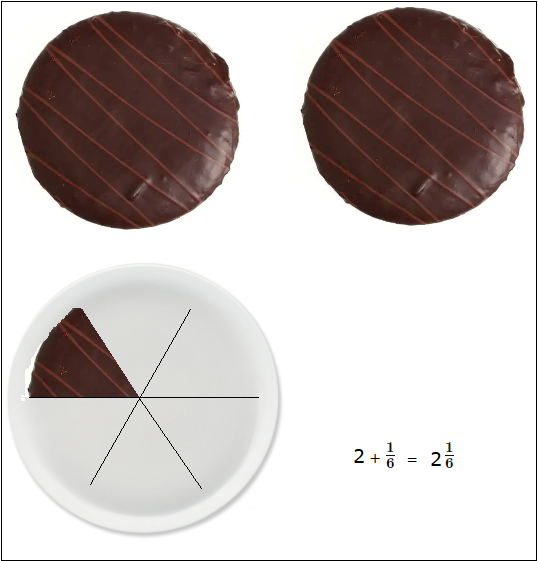1) Fractions in a Cake
2) Equivalent Fractions
3) Common Denominators
4) Proper and Improper Fractions
5) Mixed Fraction
When beginning to learn about fractions, both proper and improper fractions.
An effective way to start off thinking about a fraction is to think of it as a part of a greater whole.
We can do this by looking at a common shape and cutting or separating it into smaller parts.
Fractions in a Cake
A standard cake is usually in the shape of a circle.

We begin with 1 whole cake.
This cake was then sliced into 6 parts, of which we have 2 remaining.
Thus we have 2 out of 6 parts of the original whole cake. \tt{\bf{\frac{2}{6}}}
Fraction Numerator and Denominator
An introduction to fractions section needs make clear what the numerator and denominator are in a fraction.
For a standard fraction, the number on the top line is called the “NUMERATOR“,
while the number on the bottom line is called the “DENOMINATOR“.
Something to make note of is that when a fraction NUMERATOR and DENOMINATOR both have same value.
The overall value of the whole fraction is the number 1. 1 = \bf{\frac{3}{3}} , 1 = \bf{\frac{7}{7}} and so on.
Introduction to Fractions,
Equivalent Fractions
Equivalent Fractions are fractions that have the same overall value, but have different numerators and denominator values.
In Math equivalent fractions can also be called equal fractions sometimes.
\bf{\frac{1}{4}} = \bf{\frac{2}{8}} = \bf{\frac{3}{12}}
These three fractions have the same value, despite having different numerators and denominators. They are equivalent or equal to each other.
Fraction Simplest Form:
Although the three fractions above were the same overall value.
it happens to be the case that \bf{\frac{1}{4}} would be the “simplest form”.
This is because the numerator and denominator of this fraction are the smallest whole numbers that could be used.
Common Denominator
When 2 or more fractions have the same denominator as each other, then they have what is referred to as a “common denominator” between them.
The fractions: \bf{\frac{1}{5}} , \bf{\frac{2}{5}} , \bf{\frac{4}{5}}
have the common denominator of 5.
The fractions: \bf{\frac{2}{9}} , \bf{\frac{5}{9}} , \bf{\frac{10}{9}}
have a common denominator of 9.
Proper and Improper Fractions
Proper and Improper Fractions are both type of fraction, but they are slightly different in classification.
When the total value of a fraction is less than 1, such as \bf{\frac{2}{3}},
this fraction is called a “proper” fraction.
But it’s also the case that a fraction can also have an overall value that is larger than or equal to 1.
Where the top line numerator is larger than or equal to the bottom line denominator.
When this happens, the fraction is then called an “improper” fraction.
The fraction \bf{\frac{6}{5}} is a basic example of an improper fraction.
Improper fractions can at times be also be called “top heavy fractions”. Because the numerator on top is the largest number of the fraction.
Unit Fractions:
The term “unit fraction” describes a fraction where the numerator on the top line is 1.
The fractions \bf{\frac{1}{3}} , \bf{\frac{1}{15}} , \bf{\frac{1}{648}} are examples of “unit fractions”.
Mixed Fractions
A fraction in Math can be written as what is known as a “mixed fraction”.
Where there is a whole number present along with a fraction part.
These mixed fractions can sometimes also be called mixed numbers.
An example of a mixed fraction is 2\bf{\frac{1}{6}}.
The whole number part is 2, while the fraction part of the number is \bf{\frac{1}{6}}.
To give an idea of this visually, again we can make use of a cake.

We have 2 whole cakes, and also \bf{\frac{1}{6}} of another cake.
- Home ›
- Fractions & Decimals › Fractions Introduction